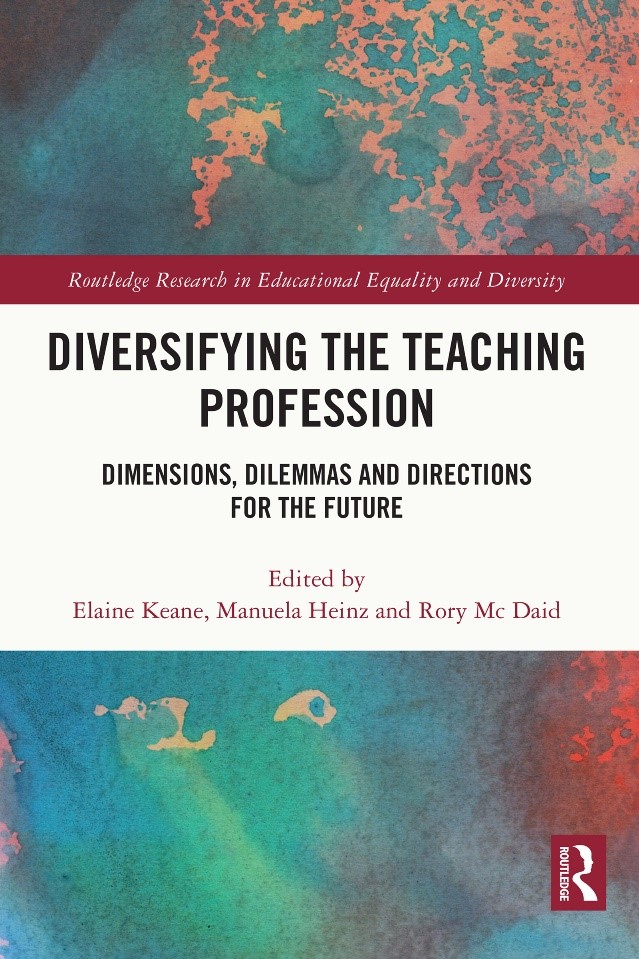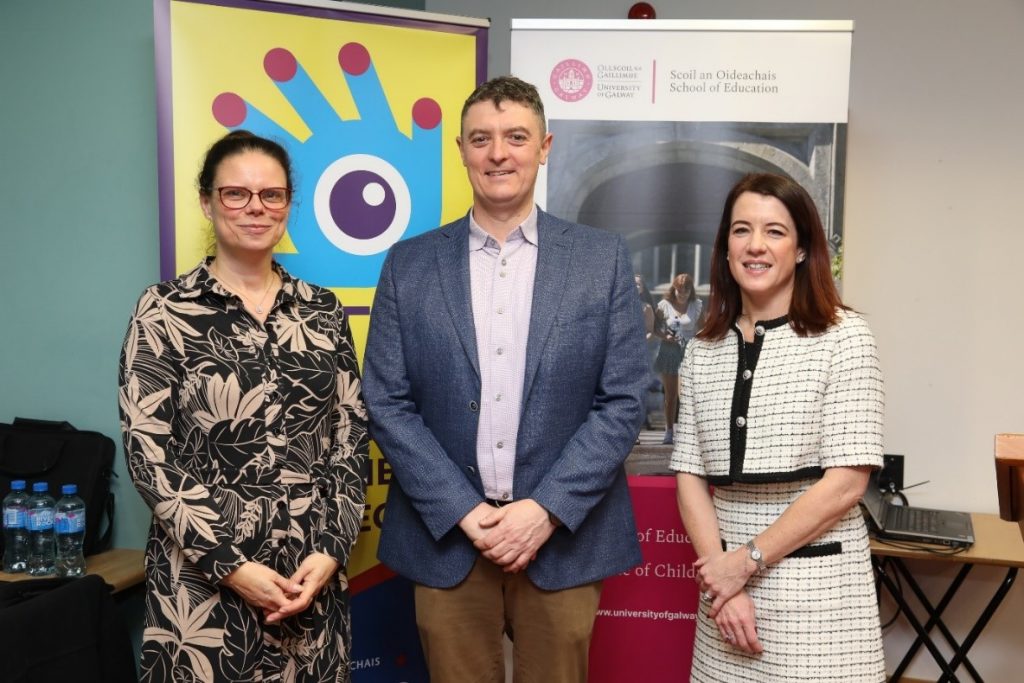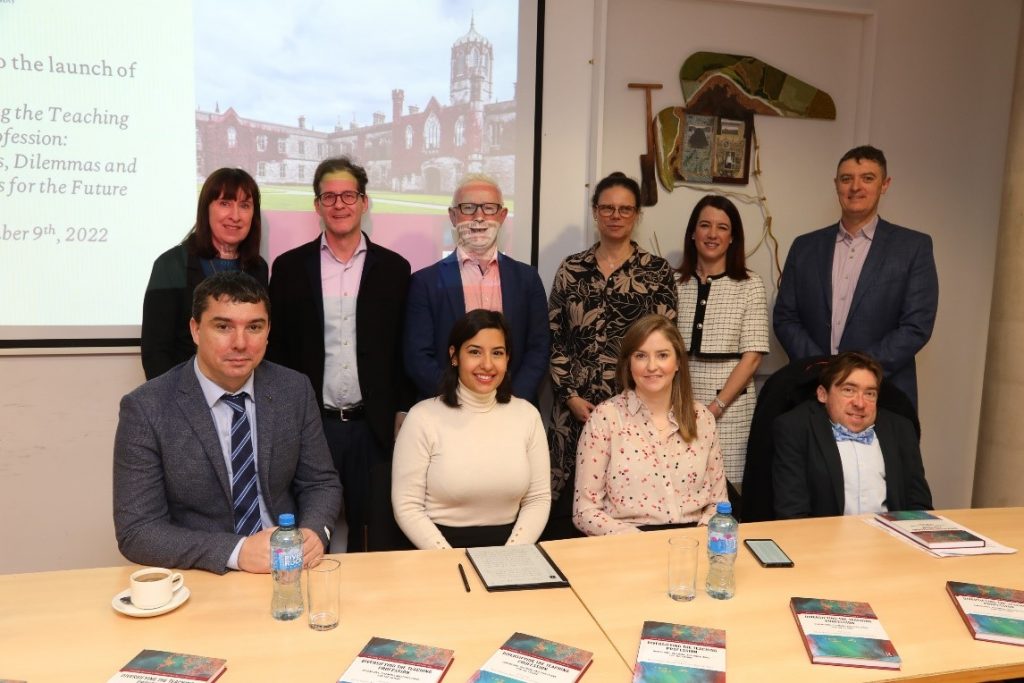Keane, E., Heinz, M. and Mc Daid, R. (Eds.) (2023) Diversifying the teaching profession: Dimensions, dilemmas and directions for the future, London: Routledge

Introduction
Our book on diversifying the teaching profession (2023) brings together 19 chapters as part of the Routledge Research in Educational Equality and Diversity series. Section I includes the introductory chapter, a chapter detailing a rationale for diversifying the teaching profession, and chapters presenting a range of international perspectives, featuring scholars from Scotland, Iceland, Australia, Portugal, England, Norway, and Ireland. Section II’s chapters report on research findings from a range of teacher diversity projects in Ireland, including but not limited to those funded under the Higher Education Authority’s (HEA) Programme for Access to Higher Education (PATH): Strand 1 (Equity of Access to Initial Teacher Education) (PATH1). Finally, Section III concludes the volume, with chapters from the editors synthesising core learning from the volume and charting pathways towards a more diverse, equitable and inclusive teaching profession. As editors, we also authored or co-authored eight of the 19 chapters.
Background to the publication
I first contacted Routledge early in 2019 with an idea for a collection of chapters about teacher diversity based on a research symposium we were hosting later that year. In Ireland, a range of teacher diversity projects, funded under PATH1, had been in operation since 2017, implemented through the six Centres of Teacher Education. This highly innovative HEA scheme, which has since invested over €5.4 million (2017-2023) in teacher diversity projects, arose from the work of the Department of Education and Skills Expert Working Group on Diversity in Initial Teacher Education (2016-17) of which I was a member. The group was established following the identification of teacher diversity as a policy goal in the National Plan for Equity of Access to Higher Education (hereafter, Access Plan) 2015-2019 (HEA, 2015) for the first time. This important policy development was informed by research undertaken as part of our Irish Research Council-funded Diversity in Initial Teacher Education (DITE) project (PIs, Dr. Elaine Keane and Dr. Manuela Heinz, School of Education), hosted by the Moore Institute, from 2013-2015. The DITE project established Ireland’s first national dataset of the socio-demographic profile of applicants and entrants to State-funded initial teacher education (ITE) programmes. Through our publications, we demonstrated the very significant homogeneity of Ireland’s ITE cohorts, in terms of being predominantly female, White, of the majority ethnic group, and, especially at primary teaching level, predominantly middle class.
By 2019, the various teacher diversity projects were in full swing. One of the projects was our own, the Access to Post-primary Teaching (APT) project, a joint School of Education, University of Galway and St. Angela’s College, Sligo, initiative through which we supported the recruitment and participation of those from lower socio-economic groups in postgraduate post-primary ITE. From speaking with other PATH1 leads, there was an appetite to share experiences about project implementation as well as emerging research findings. As part of our APT dissemination, we decided to host a research symposium on the theme. Following a call for abstracts during the summer, Ireland’s first international symposium on teacher diversity took place in the School of Education, University of Galway on November 19th, 2019. Opened by (then) Vice-President for Diversity, Equality and Inclusion, Professor Anne Scott, with Keynote Speaker, Professor Liz Thomas (University of York, and former Lead Adviser for Widening Participation in the Higher Education Academy, UK), this important event showcased research from national HEA-funded PATH1 teacher diversity projects, as well as from Dr. Rory Mc Daid (Marino Institute of Education, Dublin), lead of the Migrant Teacher Project. The symposium also featured leading international speakers in the field, including Professor Clea Schmidt (University of Manitoba, Canada) and Professor Hanna Ragnarsdóttir (University of Iceland), each of whom had led international projects in the area. Most presenters were interested in having a chapter based on their presentations considered for the edited volume, and a detailed proposal was subsequently prepared for and approved by the Board of Routledge. And so, we set to work, right at the commencement of the pandemic!
Having researched the field for some time individually and together, as editors, we were eager to bring together relevant theories, sets of empirical findings, and underpinning philosophies from diverse literatures and research bases, to show why diversifying the teaching profession was important, not just for individual teachers from under-represented groups, but also for wider society. Including so many dimensions of diversity was, as Professor Marilyn Cochran Smith noted in the Foreword to our book, not particularly straightforward, given that each dimension has its own philosophical underpinnings, theoretical leanings, and scholarly traditions, which were not always in alignment with each other. Reconciling the argumentation cohesively was challenging and doing so required us to continually revisit our core concerns.
Core concerns of the volume
In the book, we argue that a lack of diversity in the teaching profession is problematic for a number of reasons. Firstly, from an equity of access perspective, various barriers exist in the system for those from certain minority and/or disadvantaged groups in terms of being able to access the profession. Evidently, that’s a problem for anyone from these groups who would like to become a teacher, as they are constrained in pursuing their educational and professional goals because of their circumstances or identities. Secondly, from a wider equity perspective, a lack of diversity in the teaching profession is problematic because of the significant benefits that accrue to society from having a diverse teaching body. By not having people from minority and disadvantaged groups in the teaching profession, the system, and all of us in the educational community – from parents, to management, to teachers and students – are worse off; these individuals’ talents, strengths, desires, motivations, and commitment are lost to us all (see Chapters 1 and 2).
Further, and this is one of the key themes with which we engage in the book, in the context of our increasingly diversifying societal and schooling populations, the existence of a very homogeneous teaching body gives a very clear message to students – both majority and minority students – about who can be and should be a teacher, who can be and should be in a position of authority in a school and be considered an expert in a subject area – and who cannot or should not be. The issue of role-modelling is relevant here – though it is complex and requires nuanced consideration – but certainly, at a basic level, students from both privileged and disadvantaged, and minority and majority groups, all need to see teachers in front of them who constitute a much wider representation of our society than is currently the case. The basic idea of ‘you can’t be what you can’t see’ rings true and, via role-modelling, students from diverse backgrounds have the opportunity to perceive the teaching profession as something possible and potentially desirable for them to pursue. Based on international research, which has tended to focus more on ethnicity than other dimensions of diversity, there are also numerous academic, affective and other benefits for both minority and majority group students that come from having a more diverse teaching profession (see Chapter 2).
Now, there are also things against which we must guard in this work. For example, we need to be careful not to treat or see teachers from under-represented groups as homogeneous, or as, for example, cultural ‘experts’ who can and should deal with all the ‘diversity issues’ which may present in a school or classroom. Indeed, the international research is clear that doing so results in these teachers becoming pigeon-holed, overburdened, and burnt out. A further consideration is that, while research shows that there are some specific benefits for certain groups of having ‘a teacher like them’, it would be a mistake to assume that that is enough – that a sort of ‘ethnic matching’, or ‘sex matching’, or whatever matching approach is sufficient to yield all these benefits. It’s not, and like most things it’s more complex and requires a more nuanced approach. Indeed, the chapters throughout the volume point to the deep rootedness of existing structural inequalities and the impact on those from under-represented groups as they consider teaching as a career and progress in and through the profession.
And so, one of our core arguments in the book is, that yes, representation matters– it certainly does, and the current work on policy and practice levels underway in Ireland (for example, under PATH1) and internationally must continue; we need to continue to identify and address patterns of under-representation in the profession. In this regard, an important point that we emphasise is the ongoing urgent need in Ireland to recognise ethnic minoritised groups (aside from Traveller and Roma groups who are already recognised) as a target group for PATH1 projects – not as part of an existing target group, but as a target group in and of themselves, given the impact of racism on the lives of ethnic minoritized individuals. Their absence amongst the list of target groups, given their evidenced significant under-representation in the teaching profession in Ireland, remains highly problematic. In our view, if National Access Plan target groups cannot include ethnic minoritised groups, then teacher diversity policy may need to be progressed outside the remit of the National Access Plan. In terms of widening participation into the professions, target groups need to be sector-specific and research evidence-based.
While representation matters, we also argue that we must simultaneously work to change the system which has resulted in patterns of under-representation and inequality becoming a reality in the first place. Further work is required to support these teachers once they are in the system. In this regard, another core argument we make is that representation by itself is not enough; teachers from under-represented groups need to feel able to be authentically present, and they need to be adequately supported to progress through the teaching pathway, including towards and in educational leadership. For this to happen, significant work is needed at system level, to examine and transform processes, to examine and transform cultures, and to examine and transform outcomes. In this context, we argue for the importance of all teachers – and of course students – being able to be, and to be valued as, their authentic selves. A related issue is the need to ensure that we are preparing and supporting all teachers, irrespective of their background, to be effective and inclusive teachers of all pupils. Core points of learning presented throughout the volume are synthesised in Chapter 18 and are operationalised through the presentation of seven principles for the development of a diverse, equitable and inclusive teaching profession as we look to the future of teacher diversity policy and practice in Chapter 19.
Book launch and beyond
As lead editor of the collection, it was a great pleasure to work on this important project throughout the pandemic. My brilliant co-editors, Manuela and Rory, were a joy to work with and it was a genuine pleasure to collaborate with our contributors over the course of the project. The book was launched by Dr. Helen Maher, Vice President for Equality, Diversity and Inclusion, and Professor Gerry Mac Ruairc, (then) Head of the School of Education, University of Galway, in the Moore Institute on December 9th 2022. Proceedings were facilitated by Professor Daniel Carey, Director of the Moore Institute, and included a panel discussion featuring Dr. Aileen Marron (Senior Manager, Access Policy, Higher Education Authority), Dr. Vivian Rath (Research Project Officer, Reasonable Accommodations and Professional Placements Project (RAPP), Association for Higher Education Access and Disability (AHEAD)); Ms. María Florencia Sala Rothen (Independent Researcher and Teacher); and Mr. Owen Ward (Equality, Diversity and Inclusion Programme Manager for Race Equality, University of Galway). Panel members discussed the significance of the book and implications for national and international policy, practice and future research.


L-R Front Row: Mr. Owen Ward, Equality, Diversity and Inclusion Programme Manager for Race Equality; Ms. María Florencia Sala Rothen, Independent Researcher and Teacher; Dr. Aileen Marron, Senior Manager, Access Policy, Higher Education Authority; Dr. Vivian Rath, Research Project Officer, Reasonable Accommodations and Professional Placements Project (RAPP), Association for Higher Education Access and Disability (AHEAD).
There are exciting times ahead. Last year, I established the National Initial Teacher Education Diversity Network to provide a forum for discussion for PATH1 leads and associated staff with a view to continuing to influence developing national policy in the area, and we have had three productive meetings to date. As PATH1 projects are currently looking towards a potential Phase 3 of funding, the Network is currently working on a submission to the HEA consisting of a synthesis of progress to date and recommendations for Phase 3. A Special Interest Group (SIG) on Teacher Diversity within the Educational Studies Association of Ireland (ESAI) has also been established. As Convenor, my aim is to bring together established and early career researchers in the area to ascertain current research gaps and determine future research avenues in order to grow teacher diversity research nationally and internationally. At the time of writing, we are also looking ahead to October 20th, 2023, when we will host our second international symposium on teacher diversity here at the University of Galway.
We would like to thank Professor Dan Carey for his enthusiastic and long-standing support of our work in this area.
Dr. Elaine Keane, School of Education, February 2023.
Elaine Keane
Dr. Elaine Keane is Associate Professor (Sociology of Education and Research Methods) and Director of Doctoral Studies in the School of Education at the University of Galway, Ireland. Her research and publications centre on social class in education and teacher diversity, on which she has published widely, and she has led national and international funded projects in these areas. She is lead editor of the recently published book about diversifying the teaching profession (Routledge, 2023). Elaine’s research interests also include constructivist grounded theory, on which she has taught internationally and on which she is currently leading an edited volume in the context of educational research (Routledge, 2024). Elaine also serves on the Editorial Board of the UK Journal Teaching in Higher Education.

